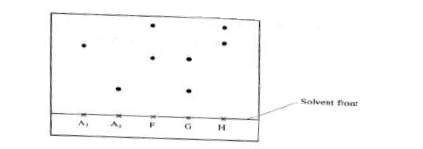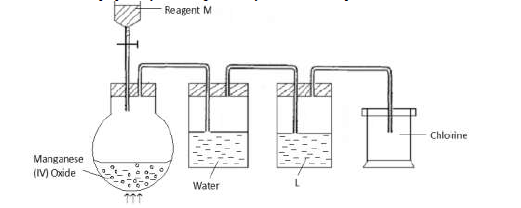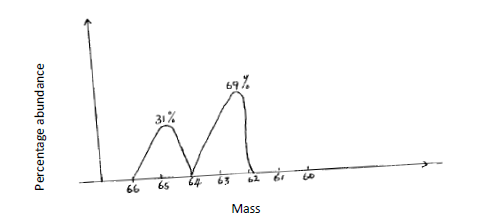i) D
ii) Giant ionic structure
iii) B is more reactive than E. It has a smaller atomic radius with greater nuclear attraction hence gains electrons more readily.
iv) C has a larger atomic radius than D. It has more protons with the same shielding effect as D hence stronger nuclear attraction.
v) Oxide of C has a higher pH value than a solution of oxide of E. C is a metal, forms a basic oxide. The oxide of E is acidic.
sharon kalunda answered the question on March 28, 2019 at 07:44
-
The half equations involved in a cell are:
(Solved)
The half equations involved in a cell are:

(a) Write the overall equation for the electrochemical cell.
(b) Calculate the e.m.f generated by a battery consisting of ten cells.
(c) State one environment advantage of using these cells in spacecrafts
Date posted:
March 28, 2019
.
Answers (1)
-
Samples of urine from three participants F, G and H at an international sports meetings were spotted onto chromatography paper alongside two from illegal drugs...
(Solved)
Samples of urine from three participants F, G and H at an international sports meetings were spotted onto chromatography paper alongside two from illegal drugs A1 and A2. A chromatogram was run using methanol. The figure below shows the chromatogram.

(a) Identify the athlete who had used an illegal drug.
(b) Which drug is more soluble in methanol?
Date posted:
March 28, 2019
.
Answers (1)
-
Zinc reacts with both concentrated and dilute sulphuric (VI) acid. Write equations for the two reactions.
(Solved)
Zinc reacts with both concentrated and dilute sulphuric (VI) acid. Write equations for the two reactions.
Date posted:
March 28, 2019
.
Answers (1)
-
When a hydrated sample of calcium sulphate CaSO4.xH2O was heated until all the water was lost, the following data was recorded:
Mass of crucible = 30.296...
(Solved)
When a hydrated sample of calcium sulphate CaSO4.xH2O was heated until all the water was lost, the following data was recorded:
Mass of crucible = 30.296 g
Mass of crucible + hydrated salt = 33.111 g
Mass of crucible + anhydrous salt = 32.781 g
Determine the empirical formula of the hydrated salt
(CA = 40, S = 32, O = 16 H = 1)
Date posted:
March 28, 2019
.
Answers (1)
-
Molecular substances have low melting points. Give one reason why they have low melting points.
(Solved)
Molecular substances have low melting points. Give one reason why they have low melting points.
Date posted:
March 28, 2019
.
Answers (1)
-
State the type of bond that exists between the NH4+ ion and H+ ion.
(Solved)
State the type of bond that exists between the NH4+ ion and H+ ion.
Date posted:
March 28, 2019
.
Answers (1)
-
Using a dot (.) and cross (x) show how NH4+ ion is formed from NH3 molecule and H+ ion.
(Solved)
Using a dot (.) and cross (x) show how NH4+ ion is formed from NH3 molecule and H+ ion.
Date posted:
March 28, 2019
.
Answers (1)
-
The set up of diagram shown below is used to prepare dry nitrogen gas from air. Study it and answer the questions that follow.
(Solved)
The set up of diagram shown below is used to prepare dry nitrogen gas from air. Study it and answer the questions that follow.

(a) What is the purpose of using:
(i) A burning candle.
(ii) Sodium hydroxide solution.
(b) Name:
(i) One impurity present in nitrogen gas prepared.
(ii) A suitable drying agent used.
Date posted:
March 28, 2019
.
Answers (1)
-
The set-up below was used to prepare dry chlorine gas. Study and answer the questions that follow
(Solved)
The set-up below was used to prepare dry chlorine gas. Study and answer the questions that follow

(a) Name reagents M and substance L.
(b) A warm red phosphorus was lowered into the gas jar of chlorine using a deflagrating spoon:
(i) State any one observation made in this experiment.
(ii) Identify the substance formed in the above reaction.
(c) Both substances in (ii) above undergo hydrolysis when exposed to air. Write an equation to show how anyone of them undergoes hydrolysis.
Date posted:
March 28, 2019
.
Answers (1)
-
To which homologous series does the compound below belong?
(Solved)
To which homologous series does the compound below belong?

Date posted:
March 28, 2019
.
Answers (1)
-
Write the equation for the reaction between the organic compound C4H10O and sodium metal.
(Solved)
Write the equation for the reaction between the organic compound C4H10O and sodium metal.
Date posted:
March 28, 2019
.
Answers (1)
-
Suppose 180cm3 of a 2.0M solution is diluted to 1.0dm3. What will be the concentration of the resulting solution?
(Solved)
Suppose 180cm3 of a 2.0M solution is diluted to 1.0dm3. What will be the concentration of the resulting solution?
Date posted:
March 28, 2019
.
Answers (1)
-
Substance L, M, N and P have the following properties.
(Solved)
Substance L, M, N and P have the following properties.

(a) Select the letter which represents a substance which is suitable for making kettle handles.
(b) Which letter represents a substance which is likely to be sodium chloride?
(c) Name the bond structure and bond type likely to be in L.
(i) Bond structure
(ii) Bond type
Date posted:
March 28, 2019
.
Answers (1)
-
Cyanogen is a gaseous compound of carbon and nitrogen only. On complete combustion in oxygen, 250cm3 of cyanogen form 500cm3 of Carbon (IV) Oxide and...
(Solved)
Cyanogen is a gaseous compound of carbon and nitrogen only. On complete combustion in oxygen, 250cm3 of cyanogen form 500cm3 of Carbon (IV) Oxide and 250cm3 of nitrogen. Determine the formula of cyanogen.
Date posted:
March 28, 2019
.
Answers (1)
-
Use the information below to answer the questions that follow.
(Solved)
Use the information below to answer the questions that follow.

Calculate the molar enthalpy of formation of butane (C4H10) from its elements in their normal states.
Date posted:
March 28, 2019
.
Answers (1)
-
State two properties that vulcanized rubber possesses as a result of vulcanization.
(Solved)
State two properties that vulcanized rubber possesses as a result of vulcanization.
Date posted:
March 28, 2019
.
Answers (1)
-
A solution of 100cm3 of 0.1M ethanoic acid has a different p.H value from that of 100cm3 of 0.1M hydrochloric acid.Explain the difference.
(Solved)
A solution of 100cm3 of 0.1M ethanoic acid has a different p.H value from that of 100cm3 of 0.1M hydrochloric acid.Explain the difference.
Date posted:
March 28, 2019
.
Answers (1)
-
Write an ionic equation for the reaction between copper II ions in solution and excess ammonia solution.
(Solved)
Write an ionic equation for the reaction between copper II ions in solution and excess ammonia solution.
Date posted:
March 28, 2019
.
Answers (1)
-
Three nitrates Q, R, and S were each heated and the products formed were tabulated as shown below.
(Solved)
Three nitrates Q, R, and S were each heated and the products formed were tabulated as shown below.

(a) Identify S and R
(b) What is the name given to elements in the same group as Q?
Date posted:
March 28, 2019
.
Answers (1)
-
The diagram below shows the percentage abundance of the isotopes of copper.
(Solved)
The diagram below shows the percentage abundance of the isotopes of copper.

(a) Calculate the relative atomic mass of copper from the information on the graph.
(b) Write the isotope formula of the most abundant isotope of copper indicating the mass number and atomic number.(copper has
29 protons)
Date posted:
March 28, 2019
.
Answers (1)